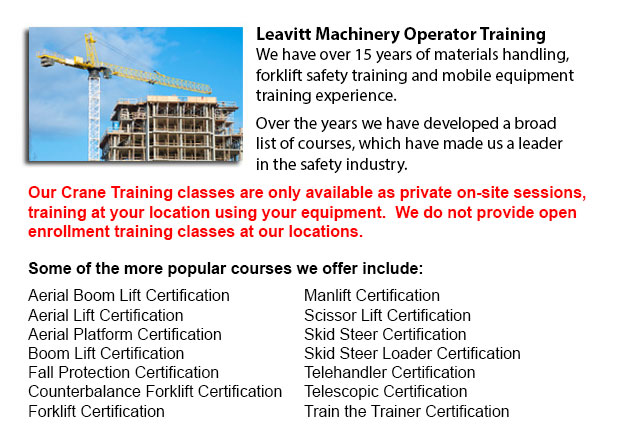
Kelowna Overhead Crane Safety Training - The overhead crane safety training course is meant to equip the operators with the right skills and knowledge in the areas of: crane safety measures, materials handling, accident avoidance, and equipment and stock protection. Each of the trainees would get to learn on numerous types of overhead cranes, their capabilities and their uses in various settings. For operators who are trained and licensed, the shift in liability moves from the company to the operator. Thus, the program emphasizes individual operator duties.
Overhead crane safety training instructs operators in the right methods for carrying out inspections. Two kinds of pre-shift check are the walk-around inspection and the in-depth inspection. These are critical daily routines that should be logged. Properly recorded pre-shift checks help to protect the business from liability in case of an accident. Pre-shift checks likewise prevent costly repairs, accidents and damage. Operators learn how to designate a specific person to carry out checks, how to report problems, and how to maintain the log book.
Checks should be carried out often and documented right. The following must checked while watching for common problems: increase in the throat opening, hooks for cracks, degree of twist; hoist ropes for corrosion, loss of diameter, worn wires, kinks and bird caging, broken wires, heat and chemical damage; chains for nicks and gouges, cracks and corrosion, twists, excessive wear, distortion, stretching, pits, damage caused by extreme heat.
The operator would get to learn the correct techniques regarding correct rigging measures. The process of rigging includes the understanding of the manufacturer's data plate, determining the weight of materials to be lifted, selecting the gear, and using safe practices to secure the load. The program include in detail the following: safe working loads, and the capacities of ropes, chains, slings, hooks and shackles.
It is important to know who could operate the cranes at your facility, the job's physical requirements, and operator qualifications needed for specialized tasks and permits. Safety should be prioritized when using in the vicinity of pedestrian traffic.
The duties included in the safe crane use consists of undertaking visual inspections, checking for hydraulic leaks, checking the safety guards, testing the controls, examining the hook and hoist rope, braking mechanisms and limit switches. Proper reporting methods are critical. These topics are all covered in depth in the program.
The program likewise consists of the correct moving and lifting methods with cranes and hoists. Operators will also learn proper hand signals. Training involves how to attach the load, raise the load, abort a lift, set the load and unhook the slings.
The steps involved with moving the load, includes: starting and stopping procedures, guiding and controlling the load, working with signals and observing working conditions. In the event of power failures, the operator will need to know how to proceed. The course includes techniques for lowering the load and removing the slings, storage of equipment, parking the crane, and securing an outdoor and indoor crane.
-
Kelowna Forklift Training Program
Kelowna Forklift Training Program - The lift truck is a common powered industrial vehicle which is in wide use these days. They are sometimes called hi los, lift trucks or jitneys. A departments store would use the forklift to unload and load merchan... More -
Kelowna Crane License
Kelowna Crane License - Crane operators ought to be "credentialed", that means they ought to have a crane operator certification or license. Credentialing is considered a mandatory governmental requirement in order to practice as an operator of a cra... More -
Kelowna Boom Lift Safety Training
Kelowna Boom Lift Safey Training - Boom lifts fall under the type of elevated work platform or aerial lifting device. Most usually used in warehousing, construction and industry; the boom lift is so versatile that it could be utilized in almost whate... More -
Kelowna Loader Training
Kelowna Loader Training - Loader Training - Any individual who would like to operate a forklift should take a Loader Training course in order to become a certified forklift truck operator. There are a variety of ways to obtain forklift training. Cour... More -
Kelowna Aerial Lift Safety Training
Kelowna Aerial Lift Safety Training - Each and every year, there are roughly 26 construction deaths attributed to the use of aerial lifts. Most of the craftsmen killed are electrical workers, laborers, painters, ironworkers or carpenters. The majorit... More -
Kelowna Crane Ticket
Kelowna Crane Ticket - Modern cranes can either be simple or complex, based upon the nature of the application they can carry out. For example, mobile cranes are somewhat simple units. A telescopic boom and even a steel truss mounts its movable platf... More -
Kelowna Boom Lift Operator Training
Kelowna Boom Lift Operator Training - The cherry picker work platform is a type of work platform, that will typically have a bucket or platform at the end of a hydraulic lifting system. The machine is likewise referred to as a man lift, boom lift, hy... More -
Kelowna Heavy Equipment Ticket
Kelowna Heavy Equipment Ticket - Depending on the nature of the job at hand, the kind of construction equipment that a heavy equipment operator makes use of differs. Every kind of machine is made to perform particular tasks in the most effective mann... More

Leavitt Operator Training
TOLL FREE: 1-888-254-6157
101-864 McCurdy Place
Kelowna, British Columbia
forkliftcertificationkelowna.com
Email Us
About Us


